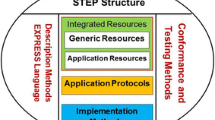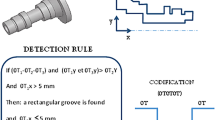Abstract
Determining the precedence of machining features is a critical issue in feature-based process planning. It becomes more complex when geometric interaction occurs between machining features. STEP-NC, the extension of STEP (ISO 10303) standard developed for CNC controllers, is a feature-based data model. It represents all the geometric and topological product data minus feature interactions. In this paper, machining precedence of interactive and non-interactive STEP-NC features is discussed. Local and global precedence of machining features are defined on the basis of geometric constraints, such as geometric interaction of features and feature approach face and technological constraint such as access direction of the cutting tool. A software tool has been developed to visualize the STEP-NC part model and to generate the graphs of feature interaction and feature precedence. The output can be then used to augment the STEP-NC data in order to generate the optimal sequence of operations.
Similar content being viewed by others
Abbreviations
- P :
-
The final part
- B :
-
The starting workpiece, blank
- F i :
-
Feature i
- ∩:
-
Interaction between two features
- \({f_{F^{i},F^{j}}}\) :
-
Common face of feature i, j
- \({F^{i}_{TAF}}\) :
-
Top approach face for feature i
- \({\vec{F}^{i}_{TAF}}\) :
-
Normal vector for top approach face for feature i
- \({\vec{T}_{AD}}\) :
-
Normal vector for tool access direction
- \({\phi}\) :
-
Null set
- ω i, j :
-
The interacting entity of feature i, j
- σ P (F i):
-
The common boundary of feature i and the final part
References
Amaitik S.M. and Kilic S.E. (2007). An intelligent process planning system for prismatic parts using STEP features. The International Journal of Advanced Manufacturing Technology 31(9–10): 978–993
Chu C.C.P. and Gadh R. (1996). Feature-based approach for set-up minimization of process design from product design. Computer Aided Design 28(5): 321–332
Gadh R. and Prinz F.B. (1995). Automatic determination of feature interaction in design for manufacturing analysis. Transaction of the ASME, Journal of mechanical design 117(1): 2–9
Gao S. and Shah J.J. (1998). Automatic recognition of interacting machining features based on minimal condition subgraph. Computer Aided Design 30(9): 727–739
Gao, J. X., & Sharma, R. (2002). A STEP enabled and PDM-based manufacturing planning system. The Proceedings of the 5th International Conference on Frontiers of Design and Manufacturing (ICFDM’2002), pp. 65–69.
Gao J., Zheng D.T. and Gindy N. (2004). Mathematical representation of feature conversion for CAD/CAM system integration. Robotics and Computer Integrated Manufacturing 20(5): 457–467
Gao J., Zheng D.T., Gindy N. and Clark D. (2005). Extraction/conversion of geometric dimensions and tolerances for machining features. The International Journal of Advanced Manufacturing Technology 26(4): 405–414
Hayes, C. (1990). Machining planning: A model of an expert level planning, process. Ph.D. Dissertation, Carnegie Mellon University, USA.
Hou M. and Faddis T. (2006). Automatic tool path generation of a feature-based CAD/CAPP/CAM integrated system. International Journal of Computer Integrated Manufacturing 19(4): 350–358
Ibrahim R.N. and McCormack A.D. (2005). Robustness and generality issues of feature recognition for CNC machining. The International Journal of Advanced Manufacturing technology 25(7–8): 705–713
Irani S.A., Koo H.Y. and Raman S. (1995). Feature-based operation sequence generation in CAPP. International Journal of Production Research 33(1): 17–39
ISO 13030-224. (2001). Industrial automation systems and integration; product data representation and exchange, Part 224. Application protocol: Mechanical product definition for process plans using machining features.
ISO 14649-1. (2003a). Data model for computerized numerical controllers, Part 1: Overview and fundamental principles.
ISO 14649-10. (2003b). Data model for computerized numerical controllers: Part 10: General process data.
ISO 14649-11. (2003c). Data model for computerized numerical controllers, Part 11: Process data for milling.
ISO 14649-111. (2004). Data model for computerized numerical controllers, Part 111: Tools for milling machines.
ISO 13030-240. (2005). Industrial automation systems and integration; product data representation and exchange, Part 240: Application protocol: Process plans for machined products.
Joshi S. and Chang T.C. (1988). Graph-based heuristics for recognition of machined features from a 3D solid model. Computer-Aided Design 20(2): 58–66
Kannan B. and Wright P.K. (2004). Efficient algorithms for automated process planning of 2.5D machined parts considering fixturing constraints. International Journal of Computer Integrated Manufacturing 17(1): 16–28
Kim Y.S., Wang E. and Rho H.M. (2001). Geometry based machining precedence reasoning for feature based process planning. International Journal of Production Research 39(10): 2077–2103
Lau H.C.W., Lee C.K.M., Jiang B., Hui I.K. and Pun K.F. (2005). Development of a computer-integrated system to support CAD to CAPP. International Journal of Advanced Manufacturing Technology 26(9–10): 1032–1042
Li W.D., Ong S.K. and Nee A.Y.C. (2002). Recognizing manufacturing features from a design by feature model. Computer Aided Design 34(11): 849–868
Liu X. (2000). CFACA: Component framework for feature-based design and process planning. Computer Aided Design 32(7): 397–408
Liu Z. and Wang L. (2007). Sequencing of interacting prismatic machining features for process planning. Computers in Industry 58(4): 295–303
Marefat M. and Kashyap R.L. (1990). Geometric reasoning for recognition of three-dimensional object features. IEEE Transactions on Pattern Analysis and Machine Intelligence 12(10): 949–965
Medani O. and Ratchev S.M. (2006). A STEP AP224 agent-based early manufacturability assessment environment using XML. International Journal of Advanced Manufacturing Technology 27(9–10): 854–864
Nasr E.A. and Kamrani A. (2007). Computer-based design and manufacturing: An information-based approach. Springer, USA, 181–201
Nassehi A., Liu R. and Newman S.T. (2007). A new software platform to support feature-based process planning for interoperable STEP-NC. International Journal of Computer Integrated Manufacturing 20(7): 669–683
Open Cascade Technology. (2000). The applications of open cascade in CAD/CAM/CAE, http://www.opencascade.org/occ/areas/cadcamproducts/. Accessed 13 May 2008.
Sormaz D.N. and Khoshnevis B. (2000). Modeling of manufacturing feature interactions for automated process planning. Journal of Manufacturing Systems 19(1): 28–45
Sormaz D.N., Arumugam J. and Rajaraman S. (2004). Iintegrative process plan model and representation for intelligent distributed manufacturing planning. International Journal of Production Research 42(17): 3397–3417
STEP Tools Incorporation. (2008). http://www.steptools.com/. Accessed 13 May 2008.
Suh S.H. and Cheon S.U. (2002). A framework for an intelligent CNC and data model. International Journal of Advanced Manufacturing Technology 19(10): 727–735
Suh, H., Ahluwalia, R. S., & Miller, J. E. (1991). Feature generation in concurrent engineering environment. In The Proceedings of the First ACM Symposium on Solid Modeling.
Suh S.H., Lee B.E., Chung D.H. and Cheon S.U. (2003). Architecture and implementation of a shop-floor programming system for STEP-compliant CNC. Computer Aided Design 35(12): 1069–1083
Trika S.N. and Kashyap R.L. (1993). Geometric reasoning for extraction of manufacturing features in iso-oriented polyhedrons. IEEE Transactions on Pattern Analysis and Machine Intelligence 16(11): 1087–1100
Tsing Y.J. and Joshi S.B. (1994). Recognizing multiple interpretations of interacting machining features. Computer Aided Design 26(9): 667–88
Vandenbrande, J. H. (1990). Automatic recognition of machinable features in solid models. Ph.D. thesis, University of Rochester, USA.
Wang L. and Shen W. (2003). DPP: An agent-based approach for distributed process planning. Journal of Intelligent Manufacturing 14(5): 429–439
Wang L., Cai N., Feng H.Y. and Liu Z. (2006). Enriched machining feature-based reasoning for generic machining process sequencing. International Journal of Production Research 44(8): 1479–1501
Wong K.W., Lam K.M. and Siu W.C. (2001). An efficient algorithm for human face detection and facial feature extraction under different. Pattern Recognition 34(10): 1993–2004
Woo Y., Wang E., Kim Y.S. and Rho H.M. (2005). A Hybrid feature recognizer for machining process planning systems. CIRP Annals-Manufacturing Technology 54(1): 397–400
Xu, X. W. (2001). Feature recognition methodologies and beyond, Mechanical engineering transactions. ME25 No. 1.
Xu X.W. (2005). Novel surface and volumetric feature interactions for process planning. International Journal of Computer Applications in Technology 24(4): 185–194
Xu X.W. (2006). Realization of STEP-NC enabled machining. Robotics and Computer-Integrated Manufacturing 22: 144–153
Xu X.W. and Hinduja S. (1997). Determination of finishing features in 2 1/2D components. Proceedings of the Institution of Mechanical Engineers, Part B: Journal of Engineering Manufacture 211(2): 125–142
Xu X.W. and Hinduja S. (1998). Recognition of rough machining features in 2.5D components. Computer Aided Design 30(7): 503–516
Xu X.W. and Newman S.T. (2006). Making CNC machine tools more open, interoperable and intelligent; a review of the technologies. Computers in Industry 57(2): 141–152
Author information
Authors and Affiliations
Corresponding author
Rights and permissions
About this article
Cite this article
Mokhtar, A., Xu, X. & Lazcanotegui, I. Dealing with feature interactions for prismatic parts in STEP-NC. J Intell Manuf 20, 431–445 (2009). https://doi.org/10.1007/s10845-008-0144-y
Received:
Accepted:
Published:
Issue Date:
DOI: https://doi.org/10.1007/s10845-008-0144-y




